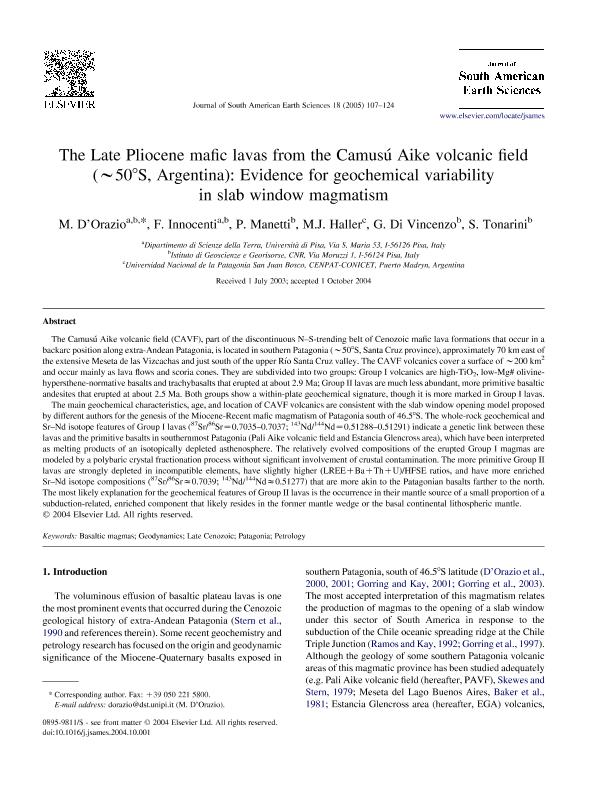Artículo
The Late Pliocene mafic lavas from the Camusú Aike volcanic field (∼50°S, Argentina): Evidence for geochemical variability in slab window magmatism
D'Orazio, M.; Innocenti, F.; Manetti, Pablo Luis; Haller, Miguel Jorge F. ; Di Vincenzo, G.; Tonarini, S.
; Di Vincenzo, G.; Tonarini, S.
 ; Di Vincenzo, G.; Tonarini, S.
; Di Vincenzo, G.; Tonarini, S.
Fecha de publicación:
01/2005
Editorial:
Pergamon-Elsevier Science Ltd
Revista:
Journal of South American Earth Sciences
ISSN:
0895-9811
Idioma:
Inglés
Tipo de recurso:
Artículo publicado
Clasificación temática:
Resumen
The Camusu Aike volcanic field (CAVF), part of the discontinuous N–S-trending belt of Cenozoic mafic lava formations that occur in a backarc position along extra-Andean Patagonia, is located in southern Patagonia (w508S, Santa Cruz province), approximately 70 km east of the extensive Meseta de las Vizcachas and just south of the upper Rio Santa Cruz valley. The CAVF volcanics cover a surface of ~ 200 km2 and occur mainly as lava flows and scoria cones. They are subdivided into two groups: Group I volcanics are high-TiO2, low-Mg# olivine-hypersthene-normative basalts and trachybasalts that erupted at about 2.9 Ma; Group II lavas are much less abundant, more primitive basaltic andesites that erupted at about 2.5 Ma. Both groups show a within-plate geochemical signature, though it is more marked in Group I lavas. The main geochemical characteristics, age, and location of CAVF volcanics are consistent with the slab window opening model proposed by different authors for the genesis of the Miocene-Recent mafic magmatism of Patagonia south of 46.58S. The whole-rock geochemical and Sr–Nd isotope features of Group I lavas (87Sr/86Sr=0.7035–0.7037; 143Nd/144Nd=0.51288–0.51291) indicate a genetic link between these lavas and the primitive basalts in southernmost Patagonia (Pali Aike volcanic field and Estancia Glencross area), which have been interpreted as melting products of an isotopically depleted asthenosphere. The relatively evolved compositions of the erupted Group I magmas are modeled by a polybaric crystal fractionation process without significant involvement of crustal contamination. The more primitive Group II lavas are strongly depleted in incompatible elements, have slightly higher (LREE+Ba+Th+U)/HFSE ratios, and have more enriched Sr–Nd isotope compositions (87Sr/86Sr=0.7039; 143Nd/144Nd=0.51277) that are more akin to the Patagonian basalts farther to the north. The most likely explanation for the geochemical features of Group II lavas is the occurrence in their mantle source of a small proportion of a subduction-related, enriched component that likely resides in the former mantle wedge or the basal continental lithospheric mantle. w508S, Santa Cruz province), approximately 70 km east of the extensive Meseta de las Vizcachas and just south of the upper Rio Santa Cruz valley. The CAVF volcanics cover a surface of ~ 200 km2 and occur mainly as lava flows and scoria cones. They are subdivided into two groups: Group I volcanics are high-TiO2, low-Mg# olivine-hypersthene-normative basalts and trachybasalts that erupted at about 2.9 Ma; Group II lavas are much less abundant, more primitive basaltic andesites that erupted at about 2.5 Ma. Both groups show a within-plate geochemical signature, though it is more marked in Group I lavas. The main geochemical characteristics, age, and location of CAVF volcanics are consistent with the slab window opening model proposed by different authors for the genesis of the Miocene-Recent mafic magmatism of Patagonia south of 46.58S. The whole-rock geochemical and Sr–Nd isotope features of Group I lavas (87Sr/86Sr=0.7035–0.7037; 143Nd/144Nd=0.51288–0.51291) indicate a genetic link between these lavas and the primitive basalts in southernmost Patagonia (Pali Aike volcanic field and Estancia Glencross area), which have been interpreted as melting products of an isotopically depleted asthenosphere. The relatively evolved compositions of the erupted Group I magmas are modeled by a polybaric crystal fractionation process without significant involvement of crustal contamination. The more primitive Group II lavas are strongly depleted in incompatible elements, have slightly higher (LREE+Ba+Th+U)/HFSE ratios, and have more enriched Sr–Nd isotope compositions (87Sr/86Sr=0.7039; 143Nd/144Nd=0.51277) that are more akin to the Patagonian basalts farther to the north. The most likely explanation for the geochemical features of Group II lavas is the occurrence in their mantle source of a small proportion of a subduction-related, enriched component that likely resides in the former mantle wedge or the basal continental lithospheric mantle.
Palabras clave:
BASALTIC MAGMAS
,
GEODYNAMICS
,
LATE CENOZOIC
,
PATAGONIA
,
PETROLOGY
Archivos asociados
Licencia
Identificadores
Colecciones
Articulos(CCT-CENPAT)
Articulos de CTRO.CIENTIFICO TECNOL.CONICET - CENPAT
Articulos de CTRO.CIENTIFICO TECNOL.CONICET - CENPAT
Citación
D'Orazio, M.; Innocenti, F.; Manetti, Pablo Luis; Haller, Miguel Jorge F.; Di Vincenzo, G. ; et al.; The Late Pliocene mafic lavas from the Camusú Aike volcanic field (∼50°S, Argentina): Evidence for geochemical variability in slab window magmatism; Pergamon-Elsevier Science Ltd; Journal of South American Earth Sciences; 18; 2; 1-2005; 107-124
Compartir
Altmétricas



